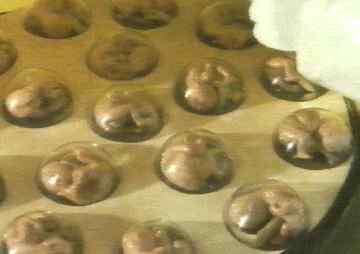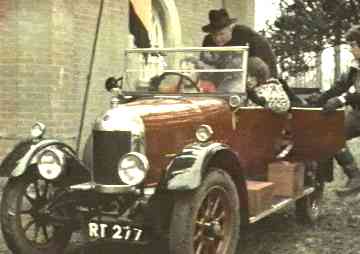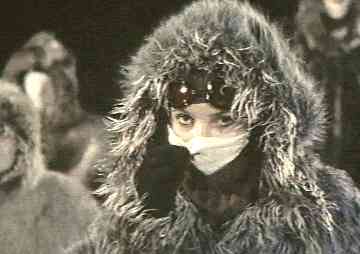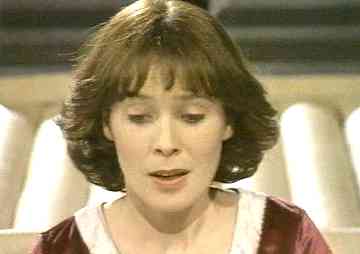
Planet with a breathable atmosphere, a probably large population and a high level of technology. What the people called themselves is open to dispute: Cally said: "My people are the Auronar" in Time Squad, but in Sarcophagus she described herself as "an Auron". Both terms might have been in equally common usage.
Just how truly alien the Auronar were is a matter of contention. Jenna referred to Cally as an alien at the end of Time Squad. Sarkoff said to her: "Your people don't originate from Earth." In Sarcophagus Cally said: "I'm not quite human." Avon in Shadow described her as "more human than I am", and the commandeered Orac in that episode told her that she was "the last of the humankind" in order to isolate her. Cally described herself as "not all that alien" in Voice from the Past. Deral remarked that the fetuses Servalan showed him looked "quite human", to which Servalan replied, "They are". The people of Auron certainly seemed to have been subjected to some form of genetic engineering, since this was the process by which Franton induced telepathic and other psi-abilities in all young Auronar. In Dawn of the Gods, Cally recited the legend of the Thaarn, stretching back over a million years, in which telepathy was described as "promised", but she admitted that this was reckoned to be just a children's story.
Another Auron legend was that of the Lost, cast out as "unfit to share the soul of Auronar" at some unspecified time. The Lost, or survivors of them, were apparently encountered by Blake as the corporate being Saymon in The Web. Saymon called Cally "our daughter", and told Blake that he and the minds of which he was comprised were "from the Auronar, but not of them".
Auron technology included development of artificial telepathy transmission: Cally knew of the project but apparently did not work on it. She recalled two members of the development team leaving Auron before she did. In Dawn of the Gods she said that Auron had yet to develop the traction beam.
Auron followed a policy of strict isolationism, although LeGrand referred to having anti-Federation sympathizers on Auron. This policy was particularly enforced after the Intergalactic War, despite being well away from the war zone. According to Avon, this was because they considered themselves too good to become involved with the rest of humanity (sic). Cally defended this on the grounds of Auron being neutral, but added with reference to herself: "We're not all gutless". The isolationist policy was made by a Council, presumably a ruling body, and opposed by clinician Franton, but as his daughter said to CA 1, "those in opposition were simply ignored". This insularity had left Auron free of all diseases for "more than three decades" according to Orac. Nevertheless, Auron did have stargoing vessels, including the C-type Patrollers, one of which was picked up by Servalan on its way back to Auron. The pilot was infected with an alien pathogen before continuing on his way home.
One of the best-known features of the Auronar was their mental powers, especially telepathy. Deral stated that all Aurons were telepathic. In Dawn of the Gods Cally said that some of her people were telepathic "to a degree". Widespread telepathy seems to have its origins in the cloning process developed by Clinician Franton snr. Cally said in Shadow that telekinesis was rare "even among my people". In Children of Auron, Servalan used an ionic beam on pilot 4-0 to prevent his telepathic abilities sensing what she was doing. This suggests that some Auronar may have had some mind-reading ability, or were popularly thought to.
 |
The other, and perhaps most distinctive, feature of Auron society was the
fact that a large and probably growing proportion of its population were
clones. A process of spontaneous cell differentiation was developed by
Clinician Franton snr. some decades prior to Liberator's visit. Most
younger Auronar were probably clones, and Cally and Zelda were from the same
sibling batch.
|
See also BOOK OF AURON, CALLY, CLONING, SAYMON, TELEKINESIS, TELEPATHY, THAARN.
Travis was suspended from duty for massacring unarmed civilians after their surrender on the planet Auros. He was later tried for the murder of 1417 people on Zircaster, and it is tempting to assume this is the same incident, although Zircaster itself was stated to be a planet. Either two different massacres took place, or Auros was also known as Zircaster.
| Sarkoff possessed an automobile, probably genuine, and neither Cally nor Blake knew what it was, other than a vehicle of some kind. Registration number was RT 277. |  |
When the crew started to try and repair the damage resulting from the attack by two Space World vessels, Avon told Cally to "strip down the auto-navigator". Whether this device was part of the navigation computers or a peripheral unit to them was unstated.
In Time Squad Zen deduced the purpose of the programmed guardians after examination of the cryogenic capsule's auto-navigation unit.
The autopsy on K47 crewman Wardin was listed by Dr Wiler as autopsy report 149,906. The law not unnaturally required that life was extinct before examination could begin, and space death autopsies were conducted in a sealed mortuary in case alien organisms were present in the corpse.
A system found on board Federation ships and the Liberator, as well as being part of the high-intensity radiation grid guarding Central Control on Earth. This system repaired damage automatically, without the need for human intervention. The obvious benefits of such a system were an overall reduction in personnel, which would be particularly valuable on board ship, freeing the remaining crew for other tasks.
The first such system is found on the Federation civilian ship London in Space Fall. The ship was caught up in a space battle, and the outer hull was punctured astern; but Raiker reported to Leylan that the 'Auto-repair circuits' were sealing it. From a later explanation by Jenna, as well as by Nova's death, it would appear that those circuits were responsible for activating the sealing gel which flooded into the endangered section and which went 'solid in seconds'.
Compared to the auto-repair system on the Liberator, the one on the London appeared to be of a far more basic nature, dealing only with structural damage, not damage to components, and with no regenerative capacity; but this was to be expected, given the latter's age and the former's far superior technology. The Liberator's auto-repair system was first mentioned in 'Time Squad'; but it was not described in detail until The Web, when the primary drive increased speed due to a deliberately induced malfunction. Zen reported that the 'automatic repair service' should have it under control in 11.302 minutes.
Later in that episode, after Cally cut the forward detector links, Zen reported that 'repair monitors are assessing the damage'; to a later question he reported that, as the partial malfunction was still not traced, 'Repair monitors are in phase two reassessment'. Later confirmed by Avon, this shows the methodical manner the auto-repair used to locate then repair the damage.
Avon demonstrated the efficacy of the system when he tried to use another of the ship's systems, bypassing the detector computer. In one of his attempts, circuit boards shorted and burned out; but the auto-repair restored the circuitry in seconds, a repair that would have taken days to repair in an ordinary computer system, suggesting that it had regenerative capability. Avon endorsed Gan's response to this of 'fantastic', pointing out that a fortune could be made from it.
Redemption demonstrated what happened to the auto-repair when the Liberator's systems were taken over. The crew had to replace damaged components manually, the replacements appearing to come from an 'auto-repair cavity'. Either some components were kept there for such an emergency; or the system could still operate at an elementary level, regenerating components there instead of in situ.
Exactly how effective the Liberator's auto-repair system could be was shown in Aftermath, when the damage suffered due to Andromedan attack overwhelmed its capacity, leading to a malfunction in the ship's life support system, forcing the crew to leave by life capsule. Despite this considerable damage, the ship was soon operating at 54% of normal capacity, increasing as the auto-repair systems completed their functions. Zen estimated that repairs would be complete in 2 hours and 34 minutes, and reported that the weapon systems were fully operational.
Despite its great abilities, the auto-repair system was unable to cope with the cloud of minute fluid particles encountered in Terminal. After going through the cloud the hull sensors stopped working and the auto-repair circuits were activated. While the substance began to corrode the Liberator's hull, it was not until later that Vila noted a 'very-high level discharge' from the energy banks, such that their regenerative capacity was exceeded. This was due to auto-repair circuits working at maximum capacity; but the damage was exceeding their recitification capacity. The result was the development of dangerous structural weaknesses in many areas of the ship, the circuits fighting a losing battle and burning up the energy banks. The final result was the breakdown of systems, including Zen, and the ship's destruction when Servalan had the main drive activated.
All the auto-repair systems shown in the series were in ships with one exception: the high-intensity radiation grid guarding the entrance to Central Control on Earth, as seen in Pressure Point. When cut, it was capable of total self-repair in 8 seconds. From what was seen, it appears to have a form of regenerative capacity, though nowhere near as sophisticated as on the Liberator.
While auto-repair systems had many benefits, they also had certain drawbacks. First, presumably due to their basic programming, they could not _anticipate future damage_, which would mean interference in human autonomy. In The Web, Zen refused to identify Cally's role in deliberately inducing the malfunction in the primary drive, as 'involvement is not permitted'; and he refused to reprogramme the system to deal with the future explosion of the bomb she attached to the primary power channel as 'Pre-emptive interference in crew activities is forbidden'.
Second, auto-repair systems were methodical. The one on the Liberator, according to Avon in The Web, 'starts at the beginning and it works its way through. It's slow'. Due to its methodical nature, Avon could anticipate how long a particular repair would take. The fact that the radiation grid in Pressure Point would take exectly 8 seconds to self-repair if cut gave the crew the chance to get to Central Control's entrance.
Third, they had to rely on other systems to find out what damage they needed to repair. The Liberator's system relied on the hull sensors; but the malfunction of the latter by the fluid particles in Terminal limited the data for analysis, thus limiting the system's capacity for repair. This, combined with the actual damage caused, eventually resulted in the ship's destruction.
See also FORBIDDEN ZONE, LIBERATOR, LONDON.
The auxiliary computer on Liberator were responsible for every minor adjustment of the ship's systems required when in flight, and were ultimately controlled by Zen. When Zen shut down, as in this episode, the auxiliary computers did likewise, and manual control of the ship became next to impossible.
A feature of the flight deck aboard Liberator: Orac gave Blake information on Wanderer class vessels through the auxiliary monitor.
| Dissident leader who had started resistance movements on over a dozen worlds. She called on Blake's help for transport to a safer planet, but was betrayed by Terloc and captured by Travis. |  |
 Android Avalon | She was duplicated in android form and planted on the Liberator, a plan known as "Project Avalon". Jenna had met her at some previous, unspecified, time before escaping with Blake to the Liberator (the android failed to recognise Jenna, and Jenna made no comment on this), and Cally said she had admired Avalon's work "for a long time". Avalon left the unnamed planet in the episode with Blake but was not seen or referred to at any later time. |
Helot freedom fighter with Hunda's 4th Column. Avandir monitored Igin's return from the city, and took part in the ambush of the adapted Helots sent out by Colonel Quute. He also took part in the assault on the city once Forbus" antidote to pylene-50 had been supplied to Hunda by Tarrant and Dayna.